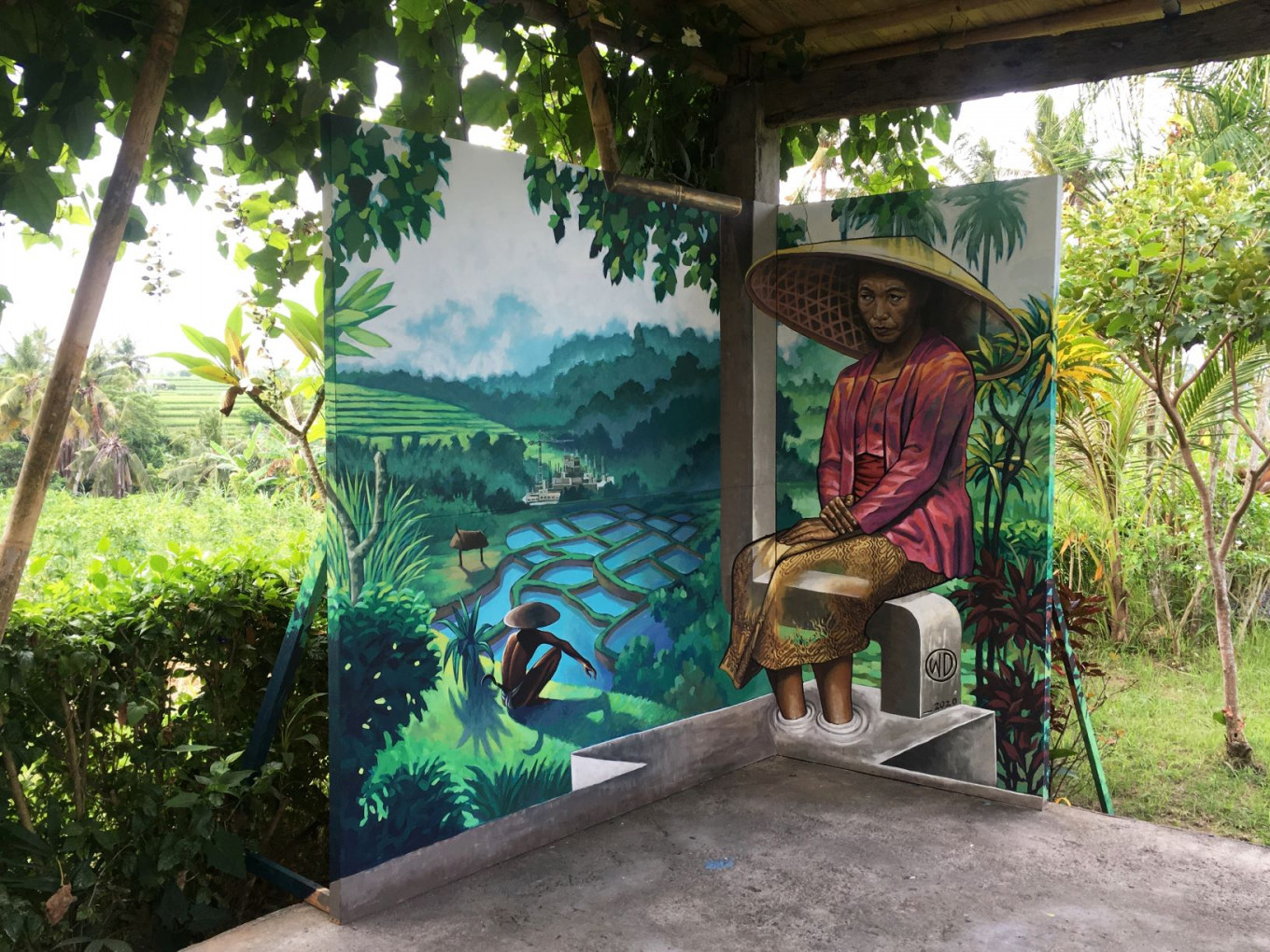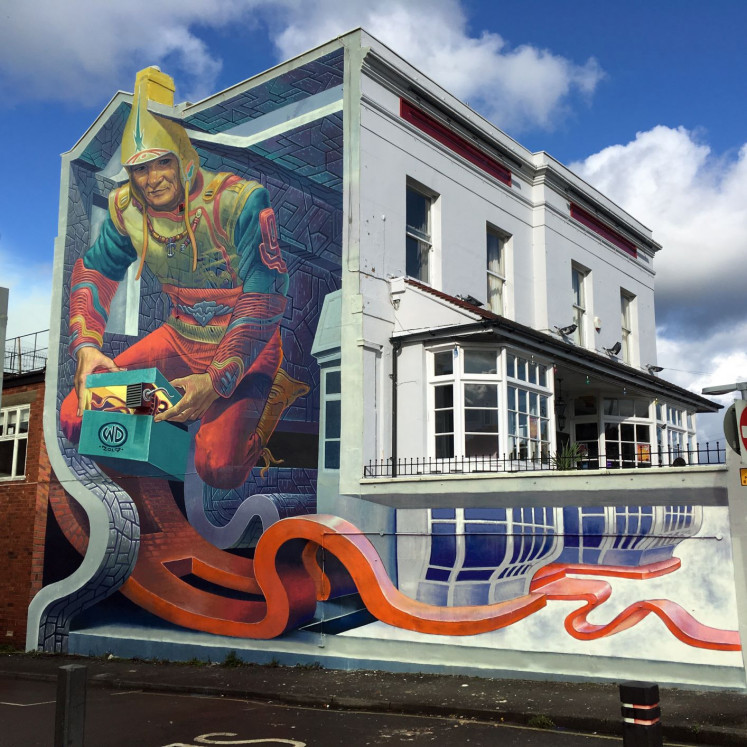Popular Reads
Top Results
Can't find what you're looking for?
View all search resultsPopular Reads
Top Results
Can't find what you're looking for?
View all search resultsGlobe-trotting muralist captures public imagination, one wall at a time
His murals may adorn walls around the world, but the Balinese muralist isn’t seeking fame.
Change text size
Gift Premium Articles
to Anyone
G
oing simply by the moniker “Wild Drawing” or WD, the artist’s murals have adorned walls in cities across Europe, Asia and North America. He has also been invited to a number of prominent art festivals. His peers, both here and abroad, revel in and revere his captivating esthetics, while volumes of titles on street art praise his fresh take on centuries-old mythology.
Yet, the 30-something muralist comes across as someone oblivious to his many accomplishments.
He speaks slowly in soft tones, with a courteous demeanor to match, and while he did provide his real name, his subsequent request shows that personal fame is not what he’s after on his artistic journey.
"Please, do not use my real name or a photograph of my face in the story," he asked, adding that it had nothing to do with creating or maintaining some kind of mystique.
"I want people to pay attention to my work and the messages embedded in them. The work is more important than my name, my face or my personal life," said WD.
Instead, he decided to be known by the pseudonym Wild Drawing, and the Instagram handle @wd_wilddrawing. Friends and fans simply call him "WD", pronounced “weh-deh” as in the phonetic Indonesian alphabet.
Going by a pseudonym in the vein of renowned street artist and activist Banksy also has a practical advantage. It gives him anonymity so he can freely enter cities and regions where street art is still viewed as nothing more than vandalism – a “charge” more commonly laid against its progenitor, graffiti. After all, he has had his fair share of brushes with the law.
Once, WD and a British artist were in the middle of painting a mural on the wall of a school in Athens when the Greek police came and arrested them. It was the week before the local election, and their mural of figures with robotic hands and ballot boxes for their heads had apparently irritated a politician who lived just down the street from the school.
"We spent one night in jail and was taken to court. Fortunately, after three [hearings], the court sided with us, stating that the mural was an artistic expression," he recalled.
Athens is not only the adoptive home of this globe-trotting muralist, it has also played a formative role in WD’s artistic journey.
Born in a tiny village on Nusa Penida, the largest of three sister islands off Bali’s southeastern coast, WD demonstrated a passion for drawing since he was a child.
He enrolled at the High School of Fine Arts (SMSR) in Gianyar before continuing his studies at the Denpasar Institute of the Arts (ISI). Although drawing comics was his primary interest back then, WD had already started delving into the realm of street art.
"It was very difficult to find a gallery to exhibit our work, so I and a couple of friends started painting murals [on public walls], treating it as an opportunity to exhibit our work on the streets. The responses we got, the conversations we had with people who lived near the murals, were truly stimulating and expanded our view," he said.
In the mid-2000s, WD took part in a comic competition held by an arts organization in Athens and won second place. The prize was a three-year scholarship to the city’s Ornerakis School of Applied Arts. He packed his bags and started out on what would become a global journey toward artistic maturity.
Athens is steeped in mythology and WD soon found himself immersed in the Olympian lore of Zeus, Athena and other deities. The myths satisfied his thirst for symbol and meaning in the eternal struggle of a world divided by class.
"I was fascinated by the fantastical quality of the mythology as well as the strong relevance it has in the current age, with the struggles and challenges we currently face," he said.
Locational art: This before-and-after composite shows 'Flirting', a mural in Albania that showcases street artist Wild Drawing’s ability to integrate the structural features of a building (left) into his murals that merge seamlessly into the local environment. (Courtesy of Wild Drawing/-)Greek mythology has been a constant source of inspiration and influence for WD's work ever since.
"My aim is quite simple: I want to bring the fantasy world into the real word," he said.
WD soon joined the local street artists in their nightly hunt for blank walls and deserted buildings. He used ancient tales and deities to give life to contemporary concerns like social justice and environmental conservation.
To date, WD has painted more than 300 murals in cities in Greece, France, UK, Sweden, Albania, Croatia, Canada, China and Indonesia.
Fantastical view: Anamorphosis and 3D illusion brings perspective and fantasy to an otherwise unassuming structure mural in Cheltenham, the United Kingdom. (Courtesy of Wild Drawing/-)His love of Greek mythology, his mastery of anamorphic art and his ability to seamlessly fuse his art with structural mediums and their environments are three reasons why his work has gained the admiration of both his peers and the public.
"I always try to incorporate the tangible aspects of a building – the windows, stairs, balconies – and the intangible aspects – the building’s history, its [residents] and its [locale] – into the mural’s design.
“In doing so, I hope to establish a connection with the building and the people who live in and around it. Hopefully, they will feel a similar connection," he said.
One of his latest murals, Land of Tears, was created while WD was "stranded" in Bali due to the COVID-19 pandemic, and is a testimony to his esthetic.
The mural is a tribute to Yu Patmi. The female farmer and environmental activist died from heart failure on March 21, 2017 during a march in Jakarta to protest the construction of a cement factory near her village in Pati regency, in the Kendeng mountains of Central Java. Her life and death symbolize the struggles of millions of farmers across the nation.
"In the old days, the biggest topic on my arid island home of Nusa Penida was how to obtain fresh water. Nowadays, it’s about how to make more money through tourism. How the times have changed," the artist mused. (ste)













